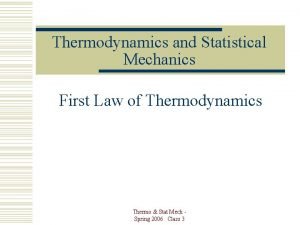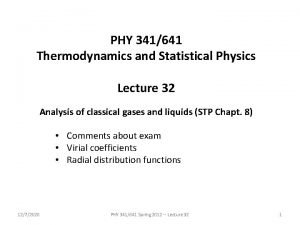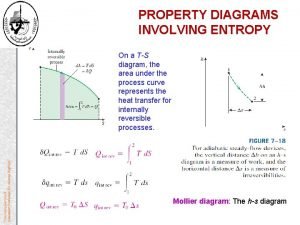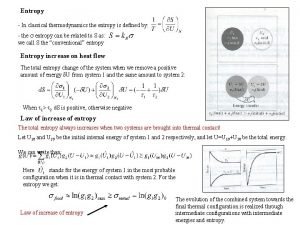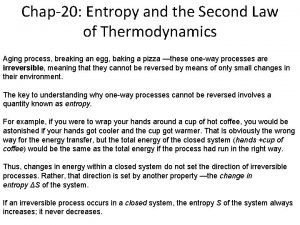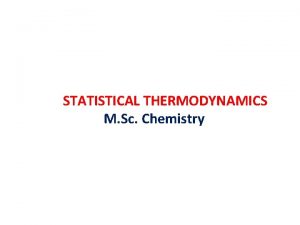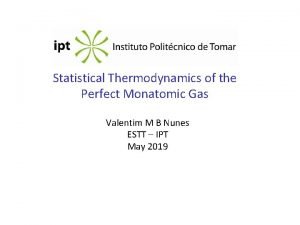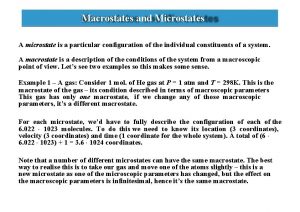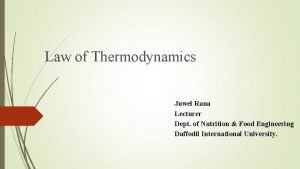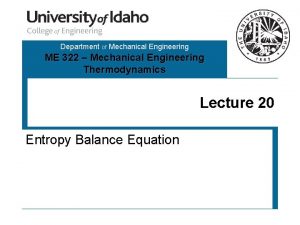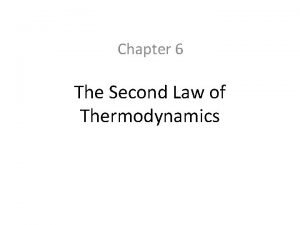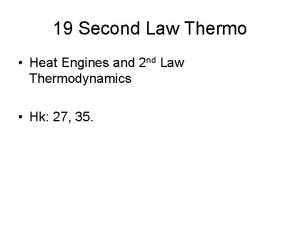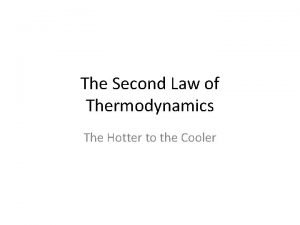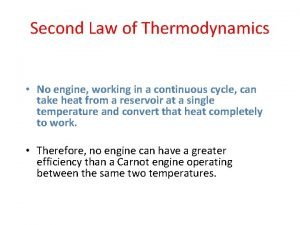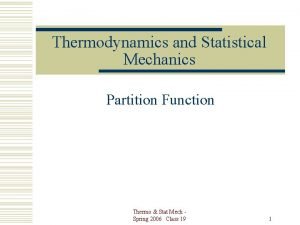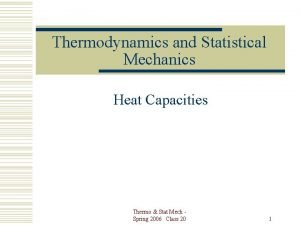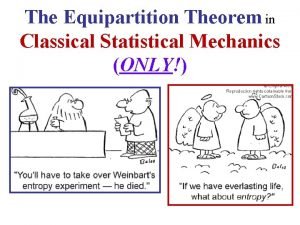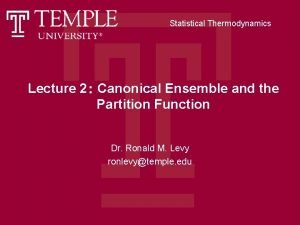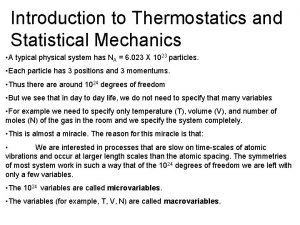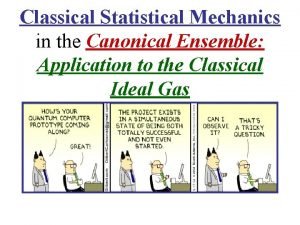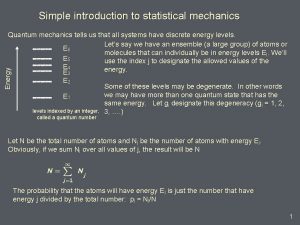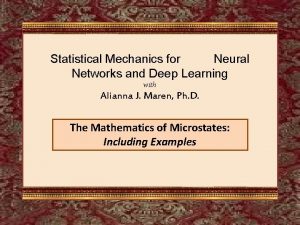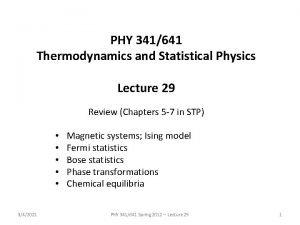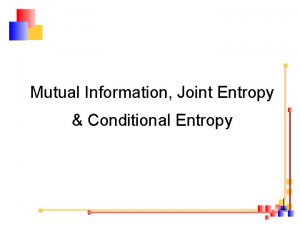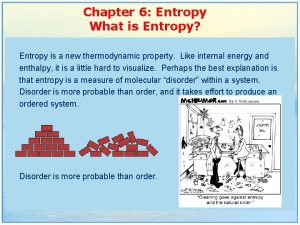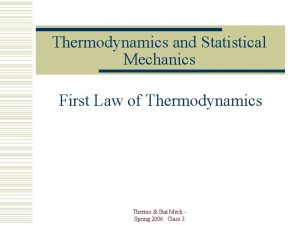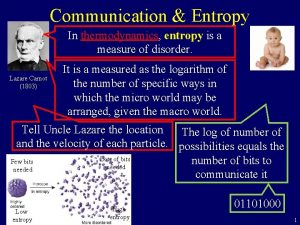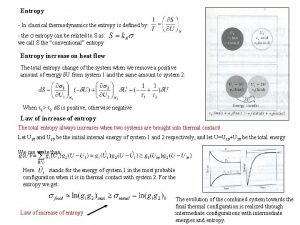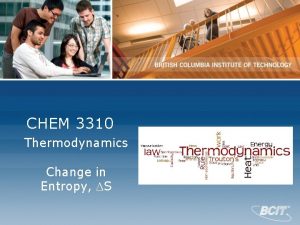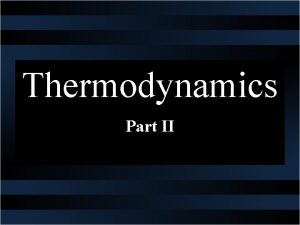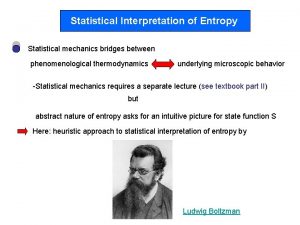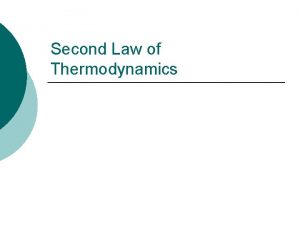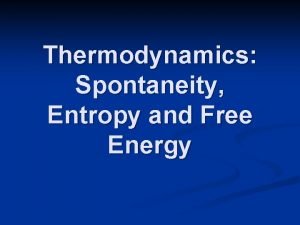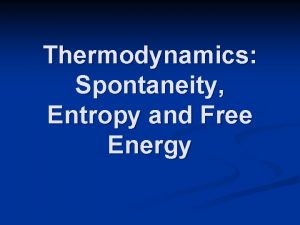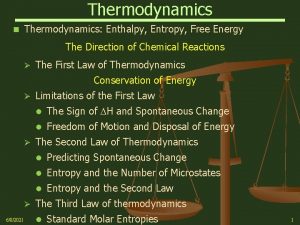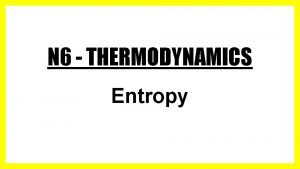Thermodynamics and Statistical Mechanics Entropy and the Second























- Slides: 23

Thermodynamics and Statistical Mechanics Entropy and the Second Law of Thermodynamics Thermo & Stat Mech Spring 2006 Class 6 1

Second Law Kelvin-Planck statement: No series of processes is possible whose sole result is the absorption of heat from a thermal reservoir and the complete conversion of this energy to work. There are no perfect engines! Thermo & Stat Mech - Spring 2006 Class 6 2

Second Law Clausius statement: No series of processes is possible whose sole result is the transfer of heat from a reservoir at a given temperature to a reservoir at a higher temperature. There are no perfect refrigerators! Thermo & Stat Mech - Spring 2006 Class 6 3

Carnot Cycle is Best A Carnot cycle is the most efficient possible, operating between two reservoirs at temperatures T 1 and T 2. Proof: Assume there is a more efficient engine. Let it produce work, and use that work to run a Carnot refrigerator between the same two reservoirs. Thermo & Stat Mech - Spring 2006 Class 6 4

Carnot Cycle is Best Thermo & Stat Mech - Spring 2006 Class 6 5

Carnot Cycle is Best Then, |Q 2¢| < |Q 2|. Also, |W| = |Q 2¢| – |Q 1¢| = |Q 2| – |Q 1|. So, |Q 2| – |Q 2¢| = |Q 1| – |Q 1¢|, and |Q 1¢| < |Q 1| also. Heat has been taken out of the low temperature reservoir and put into the high temperature reservoir with no expenditure of work! Not possible. Thermo & Stat Mech - Spring 2006 Class 6 6

For a Carnot Engine or Thermo & Stat Mech - Spring 2006 Class 6 7

For infinitesimal cycles Any cycle can be represented as a sum of infinitesimal Carnot cycles. Then, Thermo & Stat Mech - Spring 2006 Class 6 8

Carnot Cycles Thermo & Stat Mech - Spring 2006 Class 6 9

Entropy For reversible processes. Entropy is a state variable. Thermo & Stat Mech - Spring 2006 Class 6 10

Carnot Cycle Thermo & Stat Mech - Spring 2006 Class 6 11

Carnot Cycle on T-S Plot Thermo & Stat Mech - Spring 2006 Class 6 12

Carnot Cycle The area enclosed by the cycle on a P-V plot is the net work done per cycle. (đW = Pd. V) The area enclosed by the cycle on a T-S plot is the net heat added per cycle. (đQ = Td. S for any reversible process. ) These two quantities are equal. Thermo & Stat Mech - Spring 2006 Class 6 13

Irreversible “Carnot” Cycle Thermo & Stat Mech - Spring 2006 Class 6 14

Clausius Inequality Irreversible cycle In general Thermo & Stat Mech - Spring 2006 Class 6 15

Entropy Change The equal sign applies for reversible processes. Thermo & Stat Mech - Spring 2006 Class 6 16

Free Expansion of a Gas Thermo & Stat Mech - Spring 2006 Class 6 17

Free Expansion Thermo & Stat Mech - Spring 2006 Class 6 18

Isothermal Expansion Thermo & Stat Mech - Spring 2006 Class 6 19

Isothermal Expansion Reversible route between same states. đQ = đW + d. U Since T is constant, d. U = 0. Then, đQ = đW. Thermo & Stat Mech - Spring 2006 Class 6 20

Entropy Change The entropy of the gas increased. For the isothermal expansion, the entropy of the Reservoir decreased by the same amount. So for the system plus reservoir, DS = 0 For the free expansion, there was no reservoir. Thermo & Stat Mech - Spring 2006 Class 6 21

Second Law of Thermodynamics The entropy of an isolated system increases in any irreversible process and is unaltered in any reversible process. This is the principle of increasing entropy. DS ³ 0 Thermo & Stat Mech - Spring 2006 Class 6 22

First and Second Laws First Law: d. U = đQ – đW First law, combined with the second law: (for reversible processes) d. U = Td. S – Pd. V Thermo & Stat Mech - Spring 2006 Class 6 23
 Dulong petit law
Dulong petit law Thermodynamics and statistical mechanics
Thermodynamics and statistical mechanics Entropy thermodynamics
Entropy thermodynamics Entropy in thermodynamics
Entropy in thermodynamics Entropy in thermodynamics
Entropy in thermodynamics Statistical thermodynamics in chemistry
Statistical thermodynamics in chemistry Statistical thermodynamics
Statistical thermodynamics Macrostate and microstate
Macrostate and microstate Formula for entropy change
Formula for entropy change State second law of thermodynamics
State second law of thermodynamics Second law of thermodynamics
Second law of thermodynamics Second law of thermodynamics
Second law of thermodynamics Second law of thermodynamics
Second law of thermodynamics 2nd law of thermodynamics
2nd law of thermodynamics Second law of thermodynamics
Second law of thermodynamics Stat
Stat Statistical mechanics
Statistical mechanics Classical equipartition
Classical equipartition Partition function in statistical mechanics
Partition function in statistical mechanics Partition function in statistical mechanics
Partition function in statistical mechanics Partition function in statistical mechanics
Partition function in statistical mechanics Introduction to quantum statistical mechanics
Introduction to quantum statistical mechanics Statistical mechanics of deep learning
Statistical mechanics of deep learning Statistical mechanics
Statistical mechanics
